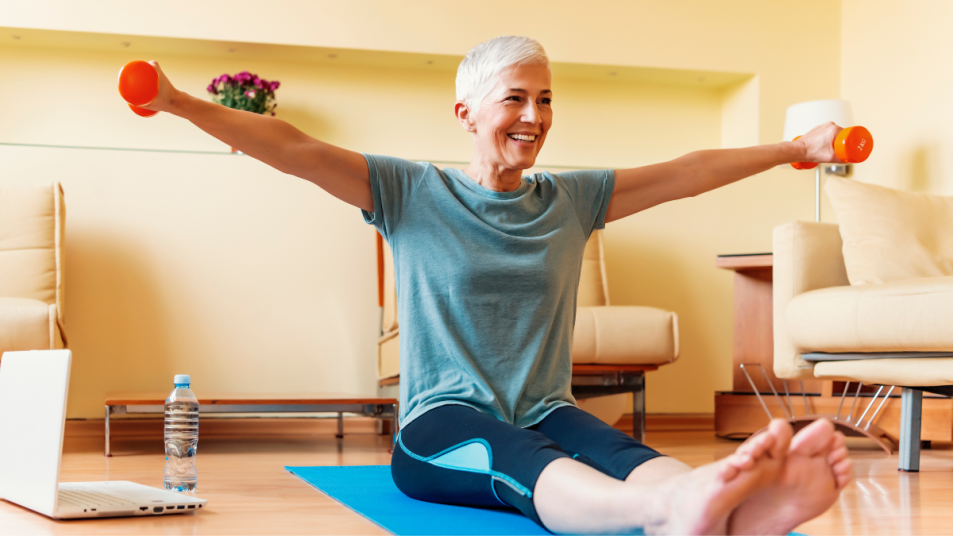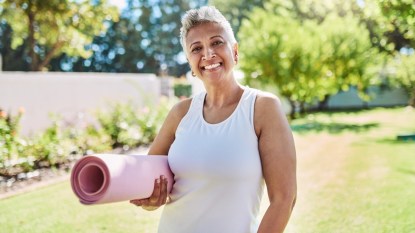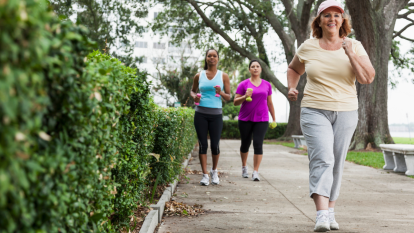Why Low-Impact Exercise May Be the Secret to Easing Depression
Plus, one therapist’s key tip for making the most of your workout

It’s no secret that regular exercise is one of the most effective treatments for depression. The rush of endorphins from a good workout can be a critical mood-booster, especially when dealing with feelings of despair or sadness.
In fact, a study recently found that regular exercise may even be more effective than medication at easing symptoms of depression. Unfortunately, the decreased mobility and joint pain that often go hand-in-hand with aging can make exercising more difficult, precisely when you need it the most.
That’s where low-impact exercise comes in. This type of workout might be just what you need to get the endorphins going without throwing out your back or straining that bad knee.
What is low-impact exercise?
Low-impact exercise is exactly what it sounds like: Cardio or weight training that doesn’t involve jumping, slamming or any sudden excessive pressure on your joints and tendons. Swimming, for example, is a classic low-impact exercise. The buoyancy of the water protects your joints and muscles from impact.
“Low-impact exercises like walking, swimming, cycling, water aerobics or yoga are gentle on the joints, but still have great cardiovascular benefits,” says Chris Mohr, PhD, RD, and Fitness and Nutrition Advisor at Fortune Recommends Health. “These exercises also can help improve balance and overall mobility, which helps reduce the risks of falls and injuries in older people.”
The health benefits of low-impact exercise
Aside from reducing the risk of falls, low-impact exercise is also essential for reducing the risk of heart attacks, strokes and dementia, says Greg Hammer, MD, former physician at Stanford University School of Medicine.
“Low impact exercise reduces stress, thereby contributing to reduced cardiovascular disease, type II diabetes, dementia and cancer, the four primary diseases of aging,” Dr, Mohr says. “Low impact exercise can provide all of these benefits without stressing our joints and causing injuries to our connective tissues and bones, thereby representing sustainability as we age.”
Related: How To Ease Depression After Illness + the Trick That Lifted an MD’s Spirits Post-Surgery
How exercise can ease depression
Regardless of age, exercise is a critical piece of your physical and mental wellbeing. “Physical well being is tightly interwoven with mental health,” says Dr. Hammer. “When we experience mild to moderate depression, we are well served by focusing our attention on the fundamentals of physical wellbeing: sleep, nutrition and exercise.”

Licensed therapist and personal trainer Rachel Goldberg explains why exercise is such a key part in fighting depression.
“The connection between exercise and depression is well-established in research,” Goldberg says. “Physical activity stimulates the production of endorphins, which are neurotransmitters in the brain known to elevate mood and reduce stress. This alleviates some symptoms of depression.”
A new study in the British Medical Journal found that low-impact exercises such as walking, yoga and strength training are up to 1.5 times more effective at combating some forms of depression than medication or traditional therapy. It also found that short-term exercise programs may actually provide more benefits than an intense regimen. That’s due to the diminishing benefits of exercise over time.
You can’t go wrong with following the general recommendation of 30-45 minutes of exercise 3-5 days per week. But even short amounts of exercise – say, 10 to 15 minutes at a time – can have cumulative benefits. Plus they help you kick those blues to the curb, no marathon training program or daily workouts required.
See also: New Study Links Depression and Weight Gain — Here Are 3 MD-Approved Ways to Restore Your Health
Exercise for depression success story
For one of Goldberg’s patients, finding the right workout completely turned around her life.
“I had a recent client who initially struggled with anxiety, depression, body image issues and recent health warnings from her doctors,” Goldberg says. “She felt overwhelmed and despised exercise, especially gyms where she felt judged. Over time, we discovered she could tolerate spin classes. This led to a massive transformation as she found a supportive community, improved her mood, reduced her anxiety and significantly boosted her physical health. For the first time, she felt athletic. This resulted in her branching out to the gym. Even more amazing is that she ended up meeting her fiancé there!”
The moral of the story? You never know what the right workout might do for your life.
How to boost the benefits of exercise for depression
Even the shortest and simplest workout is better than nothing. But to really get the most out of low-impact exercise, Goldberg recommends exercising in groups or outside.
“Exercising with someone, taking a class or being in a gym setting creates camaraderie that can also bring on feelings of connection,” Goldberg says. “For example, I’ve noticed some older folks starting to play pickleball, which can be low impact when done with others of the same athletic acumen. Connection is another way to help improve someone’s depression, because people tend to isolate when depressed.”
The added accountability of working out with a friend also increases the likelihood that you’ll stick to your plan and reap the long-term benefits of exercise. Plus, working out with someone else is just simply more fun.

For an added boost, head outdoors
“Walking is especially great on softer surfaces like grass or forest floor,” explains Dr. Hammer. “Walking outside provides the benefits of being surrounded by greenery and natural light. We can recognize that we live amidst something greater than ourselves. This alone is a powerful component to our mental health.”
And at the end of the day, the best exercise for you is the one that you stick with.
“Any form of physical activity, whether it’s walking, gentle yoga or even gardening, can have a positive impact on mood,” Goldberg says. “The key is consistency and finding activities that are enjoyable and sustainable for the individual.”
Discover more benefits of moving your body:
Fitness Experts Reveal the Best Time to Work Out + Easy Hacks That Boost the Benefit of Any Exercise
Fascia Exercises Are the 10-Minute Routine Helping Women Get One Size Smaller — Fast!
This Relaxing Type of Physical Exercise Can Ease Restless Leg Syndrome + Improve Sleep
This content is not a substitute for professional medical advice or diagnosis. Always consult your physician before pursuing any treatment plan.













